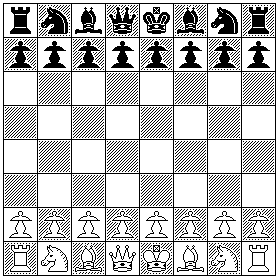
I had thought that the Internet had many pages aimed at introducing new players to Chess which gave an account of the basic rules of the game, so I had not thought to include such an account on my site originally, even after having many pages on the subject of the game. However, on having occasion to look for one such page to recommend to someone, I had some difficulty in quickly finding a page of that nature which I liked, and so I decided that it was worthwhile to place such a page here after all.
At the start of a game of Chess, the pieces are arranged as shown in the Chess diagram below:

As is currently conventional, the board is shown with the side facing the player having the Black pieces at the top.
The back row of each side of the board has the pieces in the order
Rook, Knight, Bishop, Queen, King, Bishop, Knight, Rook
in each case, starting from the right of the player having the White pieces.
The next row, ahead of the rearmost row, contains eight Pawns.
Although I hardly think it necessary, just in case to prevent any possible confusion or ambiguity,
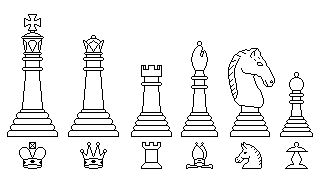
as the diagram symbols for the different Chess pieces strongly resemble the pieces they represent, I have still included the diagram above, which shows a drawing of each Chess piece above the diagram symbol used for it.
The moves of the different Chess pieces are as follows:
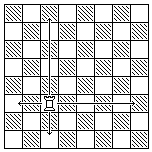
The Rook moves any number of spaces in any orthogonal direction; back and forth along a file, or from side to side along a rank.
The Rook, like the Bishop and the Queen, can't jump over other pieces: it can move in a straight line only along empty spaces, and it can also move to the first space that isn't empty, if it contains one of the opponent's pieces, which it can capture.
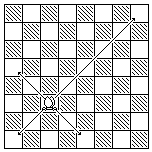
The Bishop moves any number of spaces in any of the four diagonal directions.
In addition to not being able to jump over other pieces, like the Rook, it can capture a piece of the opponent's that is on the first non-empty square of a line on which it can move; this rule also applies to the Queen.
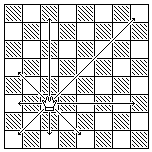
The Queen can move in either the orthogonal or diagonal directions, so it is like a Rook and a Bishop combined into one piece.

The Knight moves from the square on which it stands to any square which is displaced from that square by one unit in one orthogonal direction, and by two units in a perpendicular orthogonal direction. Of course, that's hard to describe in an easily understood manner in words, but the White knight in the diagram can move to any of the squares in the diagram that are shown as occupied by Black knights (any of which it could capture).
The Pawn normally moves one space directly forwards. But unlike the other Chess pieces, it cannot capture in the same way as it moves.
Instead, a Pawn captures by moving one space in either of the two forwards diagonal directions, if by doing so it is moving to a space occupied by one of the opponent's pieces.
On its first move, a Pawn may move two spaces directly forwards instead of one. However, if an enemy Pawn (and only an enemy Pawn, not any other enemy piece) is attacking the square directly in front of a Pawn's initial position, while the Pawn may still be moved two squares forwards, on the next move (and only then), the opponent may elect to move the attacking Pawn into that square, which the Pawn skipped over by moving two squares forwards, and capture that Pawn as a result.
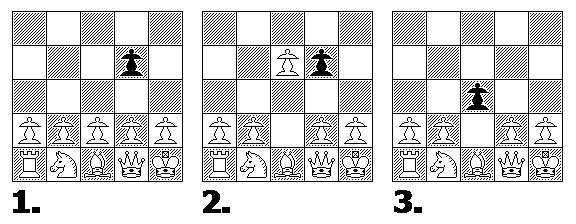
This is called en passant capture; the Pawn is captured as if it had only moved one space forwards instead of two. It is illustrated by the diagram above: 1 shows the initial situation, 2 the position after a White Pawn makes its initial two-step move, and 3 the position after Black's next move, where the Black pawn makes its normal diagonally forward capturing move into the empty square the White pawn skipped, but that White pawn is still captured by it.

The King normally moves one space only in any direction, orthogonal or diagonal.
In Chess, the objective is to capture the opponent's King... sort of.
The qualifier is needed because when you stalemate the opponent's King, the game is drawn. So a game of Chess, instead of ending when the King is captured, ends on the move just before it would be captured (that is, if it doesn't end for some other reason, leading to a draw other than a stalemate).
When another piece could capture the King, if something is not done about it (by moving the King away, putting another piece between the King and the attacking piece, or by capturing the piece making the threat) then the King is in check.
It is not permitted to leave the King in check; if possible, a player must move so that his King ceases to be in check. If it is not possible, that means the King has been checkmated, and the player has lost.
When a player's King is not in check, but no move is possible that does not cause the King to become in check, that is stalemate, which is a draw.
The King may Castle as its first move.
This move involves both the King and one of the Rooks.
The King moves two spaces instead of one in the direction of that Rook, and then the Rook moves to the space that the King skipped over.
It may take place under the following conditions:
There are still more rules to the game of Chess.
A game is drawn if exactly the same position on the board is created three times.
When no Pawns are present (since a Pawn can promote to a Queen), if neither side has enough pieces to force checkmate, the game is drawn. A player can force checkmate who has, in addition to the King, either a Queen or a Rook, or a Bishop and either a Bishop or a Knight.
Also, if fifty moves take place during which no Pawn is moved, and no piece is captured, the game is drawn.
And, of course, players can resign the game when they see their position is hopeless, or they can agree that the game is drawn if neither player sees an opportunity to win.